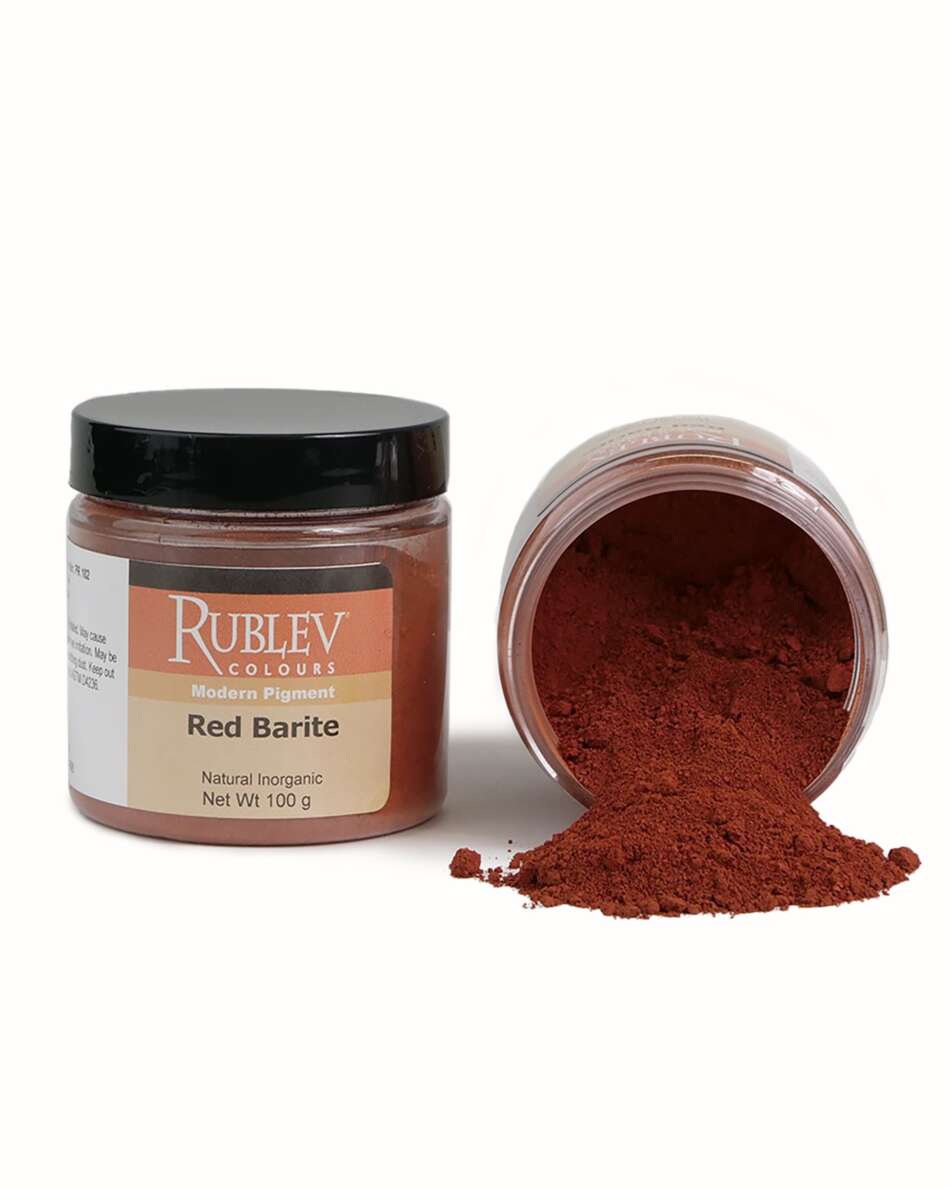Red Barite Pigment
Red Barite is a natural mineral composed of barite with various amounts of hematite, quartz, and clay. The mineral is from deposits in the Lori Province of Armenia. The colorant in Red Barite is hematite or red iron oxide, which is one of the most stable pigments known to humans.
Red Barite is a natural mineral composed mostly of barite with various amounts of hematite, quartz, and clay. The mineral is extracted from deposits in the vicinity of Akhtala, a town and municipal community in the Lori Province of Armenia, located along the Shamlugh river, on the slopes of Lalvar mountain. The colorant in Red Barite is hematite or red iron oxide, which is one of the most stable pigments known to humans. The iron oxide content of Red Barite classifies it as ocher, except that instead of large amounts of calcite, quartz, or clay, typical of ocher, our Red Barite contains barite or barium sulfate.
| Pigment Information | |
| Color: | Red |
| Pigment Classification: | Natural Inorganic |
| Colour Index: | Pigment Red 102 (77491) |
| Chemical Name: | Iron Oxide |
| Chemical Formula: | Fe2O3 |
| CAS No.: | 1345-16-0 |
| Series No.: | 4 |
| ASTM Lightfastness (based on pigment) | |
| Acrylic: | I |
| Oil: | I |
| Watercolor: | I |
| Physical Properties (based on mineral) | |
| Particle Size (mean): | 10 μ |
| Particle Size Range: | <0–15 μ: 80–85% 16–29 μ: 15–20% >30 μ: 0.1% maximum |
| Density: | 4.3 g/cm3 |
| Refractive Index: | 1.560–1.662 |
| Mohs Hardness: | 3 |
| Oil Absorption: | 24 grams oil / 100 grams pigment |
| Composition: | Barite (Ba): 41.67% Iron (Fe2O3): 28.16% Sulfur (SO3): 16.14% Silica (SiO2): 8.79% Aluminum (Al2O3): 2.06% |
| Health and Safety | There are no acute or known chronic health hazards associated with the anticipated use of this product (most chemicals are not fully tested for chronic toxicity). Always protect yourself against potentially unknown chronic hazards of this and other chemical products by keeping them out of your body. Do this by avoiding ingestion, excessive skin contact, and inhalation of spraying mists, sanding dust, and vapors from heating. Conforms to ASTM D-4236. |
For a detailed explanation of the terms in the table above, please visit Composition and Permanence.
Origin and History
Barite, baryte, or barytes (UK spelling) is a mineral consisting of barium sulfate (BaSO4). Barite is generally white or colorless and is the main source of the element barium. Barite was named in 1800 by Dietrich Ludwig Gustav Karsten from the Greek βάρυζ, heavy, due to its unusual heaviness for a non-metallic mineral.
Barite occurs in many depositional environments and is deposited through many processes including biogenic, hydrothermal, and evaporation, among others. Barite commonly occurs in lead-zinc veins in limestones, in hot spring deposits, and with hematite ore, as is the case with our Red Barite. It is often associated with the minerals anglesite and celestine.
Barite has been found at locations throughout the world and on every continent, including Australia, Brazil, Nigeria, Canada, Chile, China, India, Pakistan, Germany, to name only a few countries.
Note: Although frequently spelled barite in the U.S. and some other places, the official International Mineralogical Association (IMA) spelling is baryte.
Source
Our Red Barite is from deposits in the vicinity of Akhtala, a town and municipal community in the Lori Province of Armenia, located along the Shamlugh river, on the slopes of Lalvar mountain.


| Mineral Names | |||||||
| Names (primary mineral): | English: barite (US), baryte (UK) French: barytine German: Baryt Italian: barita Spanish: baritina | ||||||
| Common Names: | barytine, barytite, barytes, heavy spar, tiff, blanc fixe (synthetic barium sulfate) | ||||||
| Nomenclature (primary mineral): |
| ||||||
Permanence and Compatibility
Based on the colorant, iron oxide, and barite mineral, this pigment has broad compatibility and permanence with all media. Iron oxide is very lightfast and stable outdoors and has excellent weatherfastness.
Oil Absorption and Grinding
The oil absorption value for Red Barite is 24. This means 24 grams or milliliters (approx.) of linseed oil is required to form a coherent paste for every 100 grams of pigment. Barite has a Mohs hardness of 3, making it less abrasive than marble. This pigment is easy to grind into both waterborne and oil paint.
Toxicity
Red Barite is not considered a hazardous substance, however, care should be exercised when handling the pigment to avoid inhaling or ingesting the powder.
For more information on how to handle pigments safely, please visit How to Safely Handle Art Materials and Pigments.
| SKU | 453-16 |
|---|---|
| Brand | Rublev Colours |
| Vendor | Natural Pigments |
| Processing Time | Usually ships the next business day. |
| Color | Red |
| Pigment Type | Inorganic, Natural |
Health & Safety: There are no acute or known chronic health hazards with the anticipated use of this product (most chemicals are not thoroughly tested for chronic toxicity). Protect yourself against potentially unknown chronic hazards of this and other chemical products by avoiding ingestion, excessive skin contact, and inhaling spraying mists, sanding dust, and concentrated vapors from heating. Contact us for further information or consult the SDS for more information. Conforms to ASTM D-4236.



